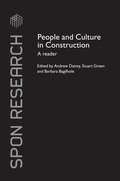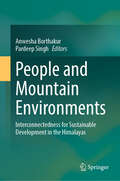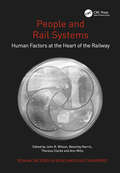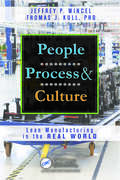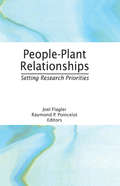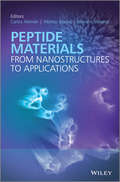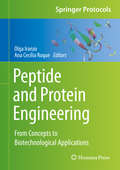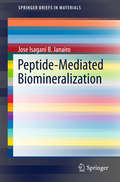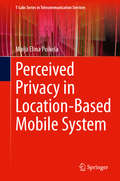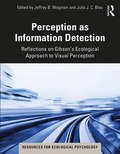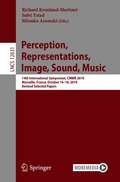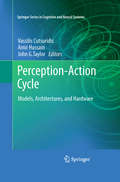- Table View
- List View
People and Culture in Construction: A Reader (Spon Research)
by Barbara Bagilhole Andrew Dainty Stuart GreenConstruction is one of the largest and most people-intensive industrial sectors. In many countries, however, construction is also one of the most highly criticized in terms of its employment practices and industrial relations. People and culture are too often seen as variables that must be manipulated in the cause of improved productivity. This important new work provides an essential corrective to the current literature by focusing on people and culture rather than sector efficiency. It presents the latest thinking from a diversity of perspectives derived from a major ESRC seminar series and invited contributions from leading researchers. Its interdisciplinary approach draws together industry and research and is international in its relevance. Through several multidisciplinary themes, People and Culture in Construction: explores the industry's labour market and the major influences on employment patterns examines how to improve the image and reality of the construction sector as an employer looks at the forces shaping the industry and implications for its stability considers the current composition of the workforce and the potential impacts of workforce diversification analyzes the impact of government targets and policies on construction working practices and culture investigates how to address the skills shortfall currently affecting the industry's performance.
People and Environment: A Global Approach
by Gareth JonesPeople and Physical Environment, A Global Approach provides an introduction to the main areas of environmental concern for geographers, environmental scientists and planners at the beginning of the twenty-first century. These include:Pollution of the atmosphere and its impact on our climate; The exploitation of the oceans; Management and supply of fresh water; Degradation of the land, and Biodiversity, and the need to maintain genetic diversity.The book argues that our knowledge and understanding of the environment is now so great that we can predict with considerable accuracy where the skills of science and technology need to be focussed in order to prevent severe environmental damage from occurring. Achieving successful management of the environment has become dependent upon active participation of a society prepared to pay for a high quality of life and the willingness of our elected politicians to legislate and enforce the very highest standards of environmental management. This book will be essential reading for students of geography, environmental studies/science and land use planners and will also contribute valuable information for climatology, biogeography, hydrology, land economy and forestry students.
People and Mountain Environments: Interconnectedness for Sustainable Development in the Himalayas
by Pardeep Singh Anwesha BorthakurPeople living in the mountains maintain a unique relationship with their surrounding environment. Humans have settled in mountainous regions all across the globe for centuries, adapting to the challenging terrains and establishing exceptional cultural practices and lifestyles. Until today, they depend on their immediate ecosystems for their everyday necessities while also conserving those environments through their own traditional practices and belief systems. Understanding and addressing the ease and complexities of the relationship between people and mountains is essential for sustainable development through overall conservation and well-being of both the environment and the communities living in these regions. The mountain communities in the Himalayas and their interconnectedness with their surroundings could provide important insights in this regard. For instance, the interaction between humans and mountains in the Himalayas is diverse, spanning across various cultural, economic, political, environmental and recreational dimensions and parameters. As sustainable development is a core goal of the world today, it is both interesting and pertinent to explore these various aspects and locate possible learnings in the present-day global environmental scenario. Accordingly, this book is an attempt to situate the interconnected between people and the mountains in the Himalayan landscape towards tracing learnings for sustainable development. Our aim is to edit a holistic volume where aspects ranging from ecosystem services to cultural and spiritual significances of the mountains for the local communities and from contributions of the Himalayas in relation to water, agriculture and food practices to the challenges associated with haphazard infrastructural developments and environmental justice implications are adequately addressed. We acknowledge that balancing the human needs of the mountain communities while ensuring environmental conservation is a major challenge. Ecologically fragile and biodiversity rich the Himalayan region is no exception. Further, mountain communities in the Himalayas are facing tremendous challenges in adapting to changing climate conditions, such as altered precipitation patterns and increased frequency of extreme weather events. Unsustainable economic activities in the form of chaotic tourism practices and infrastructural developments among others add to the emerging challenges. Accordingly, it is important to put research efforts towards active sustainable development practices where human needs are met while minimizing undesirable impacts on the Himalayan mountain ecosystems. The Himalayas are critical for global ecological balance. Therefore, this book will not only be helpful for the countries situated in these mountain regions alone, but also will provide useful insights for environmental sustainability at a much larger global scale.
People and Rail Systems: Human Factors at the Heart of the Railway (Human Factors in Road and Rail Transport)
by John R. Wilson Beverley Norris Ann MillsFollowing on from 2005's Rail Human Factors: Supporting the Integrated Railway, this book brings together an even broader range of academics and practitioners from around the world to share their expertise and experience on rail human factors. The content is both comprehensive and cutting-edge, featuring more than 55 chapters addressing the following topics: ¢ Passengers and public ¢ Driver performance and workload ¢ Driving and cognition ¢ Train cab and interfaces: simulation and design ¢ Routes, signage, signals and drivability ¢ Signalling and control of the railway ¢ Planning for the railway ¢ Engineering work and maintenance ¢ Level crossings ¢ Accidents and safety ¢ Human error and human reliability ¢ SPADs: signals passed at danger ¢ Human factors integration and standards ¢ Impairments to performance ¢ Staff competencies and training. People and Rail Systems: Human Factors at the Heart of the Railway will be invaluable for all those concerned with making railways safer, more reliable, of higher quality and more efficient. It will be essential reading for policy-makers, researchers and industry around the world.
People and Spaces in Roman Military Bases
by Penelope M. AllisonThis study uses artefact distribution analyses to investigate the activities that took place inside early Roman imperial military bases. Focusing especially on non-combat activities, it explores the lives of families and other support personnel who are widely assumed to have inhabited civilian settlements outside the fortification walls. Spatial analyses, in GIS-type environments, are used to develop fresh perspectives on the range of people who lived within the walls of these military establishments, the various industrial, commercial, domestic and leisure activities in which they and combat personnel were involved, and the socio-spatial organisation of these activities and these establishments. The book includes examples of both legionary fortresses and auxiliary forts from the German provinces to demonstrate that more material-cultural approaches to the artefact assemblages from these sites give greater insights into how these military communities operated and demonstrate the problems of ascribing functions to buildings without investigating the full material record.
People, Land and Water: Participatory Development Communication for Natural Resource Management
by Guy BessetteIn natural resource management research, best practice implies the participation of community members, research or development teams and other stakeholders to jointly identify research and development parameters and contribute to decision making. Ideally, the research or development process itself generates a situation of empowerment in which participants transform their vision and become able to take effective action. Used increasingly widely in resource management, this process is known as Participatory Development Communication (PDC). This book presents conceptual and methodological issues related to the use of PDC to facilitate participation amongst stakeholders in a variety of natural resource management initiatives. Each chapter presents in-depth experiences from Asia and Africa to highlight different ways in which this process can be achieved. The book describes the major issues involved in applying PDC to natural resource management practices and research, discusses the challenges and the difficulties linked to such an approach and offers insights and lessons from research and experience in the field.
People, Places and Landscapes
by Richard S. Krannich A. E. Luloff Donald R. FieldThis volume is a cogent empirical analysis of the interplay between a region's natural amenities and its socioeconomic evolution. It focuses on the rural sectors of America's Intermountain West region, which lies between the Cascades and Sierra Nevada mountains to the west and the Rocky Mountains to the east. Coherently structured and meticulously detailed, it adds much to our understanding of the ways an area's forests, lakes, mountains, parkland and historic attractions affect residents' sense of well-being as well as the sociodemographic and economic changes they experience. The book examines patterns of growth and change linked to the emergence of 'New West' conditions, assessing their implications for the wider community as well as discussing the impact these trends could have on the consumption of natural resources. It also points to ways in which communities and their development can be managed sustainably. The tight geographical focus of this valuable resource ensures a depth of analysis which can be applied to similar regions worldwide. Based on a large-scale, random-sample survey of both full-time and seasonal residents, it provides a much-needed overview of the macro-level economic, demographic, and social transformations affecting rural communities in America. As such, the book has relevance for all researchers concerned with rural development, the changes impacting rural landscapes, and natural resource management.
People, Process, and Culture: Lean Manufacturing in the Real World
by Jeffrey P. Wincel Thomas J. Kull, PhDExamining Lean processes in the context of the authors’ academic research in-progress, People, Process, & Culture: Lean Manufacturing in the Real World illustrates the impact of culture on the implementation of Lean Manufacturing (LM) across various geographic and cultural areas. It identifies cultural values, as examined against Lean manufacturing disciplines, and derives culturally based Lean Manufacturing (LM) values. It then assesses these cultural values in light of specific LM components, such as PULL systems and TPM, to demonstrate varying perspectives and applications. Illustrates global cultural influences on Lean implementation Uses academic research as the foundation of the material Examines the many Lean components currently in use around the world Building on the continued prominence of LM as the preferred operational approach, the book supplies time-tested advice to help you sort through the flood of information on Lean techniques and culture. It examines the numerous Lean components currently being deployed successfully around the world and identifies the limitations that can result from the varying interpretations and applications of Lean systems.Lean culture is all about Lean vision, mission, and values. This book not only identifies the Lean values required, but also supplies the understanding to integrate these values across all levels of your organization. The book will be especially helpful to international corporate managers working to demystify the sometimes hard-to-understand characteristics of Lean transformation.
People-Plant Relationships: Setting Research Priorities
by Joel Flagler Raymond P PoincelotPresenting the latest research on cross-cultural people-plant relationships, this volume conveys the psychological, physiological, and social responses to plants and the significant role these responses play in improved physical and mental health. With chapters written by field experts, it identifies research priorities and methodologies and outlines the steps for developing a research agenda to aid horticulturalists in their work with social scientists to gain a better understanding of people-plant relationships. This resource covers a wide array of topics including home horticulture and Lyme disease, indoor plants and pollution reduction, and plants and therapy.
People-Powered: Pedaling on Land, Sea, and Air (Fountas & Pinnell LLI Gold #Level O)
by Judith Lechner<p>Power Up! <p>New forms of transportation are changing the way people get around. Some new vehicles don't run on gas--they run on human energy. And they go everywhere: on land, on sea, and into the sky! <p>Text Elements: <p> <li>Genre: Nonfiction, Expository <li>Text Structures: Main: Categorical, Embedded: Description, Problem/Solution, Cause/Effect <li>Text Features: table of contents, headings, photos, captions, sidebars, glossary</li> </p>
Peppers: Biological, Health, and Postharvest Perspectives (Functional Foods and Nutraceuticals)
by Penna Suprasanna Prasad S. Variyar Vanshika Adiani Inder Pal SinghThere is an increased awareness on the relevance of nutraceutical and functional foods as alternatives to harmful synthetic additives used in industry. Different peppers, with an abundance of bioactive compounds, are highlighted in this book, which provides a comprehensive evaluaton of their importance as nutraceutical and functional foods to all stakeholders in the agri-food and pharmaceutical industries. Peppers: Biological, Health, and Postharvest Perspectives is a valuable addition to the existing information resource on peppers.Key features: Highlights the advancements made in biodiversity, biochemistry and biosynthesis of bioactive compounds of peppers. Reviews the effects of processing methods on the quality of peppers to facilitate further research and development of foods having pepper as an essential nutritional component. Provides help in selecting better processing methods for the management of nutritional attributes and health benefits of peppers. The book provides a blend of basic and advanced information for postgraduate students, researchers and scientists
Peptide Bionanomaterials: From Design to Application
by Mohamed A. ElsawyMolecular self-assembly has been exploited by nature for developing the higher functional macromolecular structures of both the genome and proteome. Inspired by nature, there has been a surge of research, in the last two decades, for the molecular engineering of peptide-based self-assembling nanostructures, adopting the bottom-up design approach. This book gives the reader an overview on the design rules for de novo self-assembling peptide and reviews the diverse range of bioinspired peptide nanostructures such as β-sheet and β-hairpin, α-helical and coiled coil, self-assembling short peptides and peptidomimetics, collagen-based and elastin-like peptides, silk peptides, peptide amphiphiles, peptides co-polymers and others. The book also covers the wide variety of responsive and functional biomaterials that have been innovated based on those nanostructures for various applications ranging from tissue engineering, therapeutics and drug delivery to antimicrobial nanomaterials and biosensors. Finally, the book also discusses the peptide bionanomaterials global market and the future of the emerging industry.Chapter “Characterization of Peptide-Based Nanomaterials” is available open access under a Creative Commons Attribution 4.0 International License via link.springer.com.
Peptide Macrocycles: Methods and Protocols (Methods in Molecular Biology #2371)
by Matthew B. Coppock Alexander J. WintonThis volume explores the latest techniques and strategies used to study the field of peptide macrocycles. The chapters in this book ae organized into four parts: macrocycles synthesis, combinational library synthesis and screening, macrocycle characterization, and unique applications. Part One looks at a variety of peptide cyclization methodologies, and Part Two describes methods for the creation of peptide macrocycles libraries and their subsequent screening against biological targets of interest. Part Three discusses the study and characterization of peptide macrocycle-target interactions, and Part Four introduces unique applications for peptide macrocycles, from higher-order structure formation to post-synthetic functional modifications. Written in the highly successful Methods in Molecular Biology series format, chapters include introductions to their respective topics, lists of the necessary materials and reagents, step-by-step, readily reproducible laboratory protocols, and tips on troubleshooting and avoiding known pitfalls. Cutting-edge and comprehensive, Peptide Macrocycles: Methods and Protocols is a valuable resource for both novice and expert researchers looking to learn more about this developing field.
Peptide Materials
by Alberto Bianco Carlos Aleman Mariano VenanziPeptides are the building blocks of the natural world; with varied sequences and structures, they enrich materials producing more complex shapes, scaffolds and chemical properties with tailorable functionality. Essentially based on self-assembly and self-organization and mimicking the strategies that occur in Nature, peptide materials have been developed to accomplish certain functions such as the creation of specific secondary structures (a- or 310-helices, b-turns, b-sheets, coiled coils) or biocompatible surfaces with predetermined properties. They also play a key role in the generation of hybrid materials e.g. as peptide-inorganic biomineralized systems and peptide/polymer conjugates, producing smart materials for imaging, bioelectronics, biosensing and molecular recognition applications.Organized into four sections, the book covers the fundamentals of peptide materials, peptide nanostructures, peptide conjugates and hybrid nanomaterials, and applications with chapters including:Properties of peptide scaffolds in solution and on solid substratesNanostructures, peptide assembly, and peptide nanostructure designSoft spherical structures obtained from amphiphilic peptides and peptide-polymer hybridsFunctionalization of carbon nanotubes with peptidesAdsorption of peptides on metal and oxide surfacesPeptide applications including tissue engineering, molecular switches, peptide drugs and drug deliveryPeptide Materials: From Nanostructures to Applications gives a truly interdisciplinary review, and should appeal to graduate students and researchers in the fields of materials science, nanotechnology, biomedicine and engineering as well as researchers in biomaterials and bio-inspired smart materials.
Peptide Nano-Chemistry and Nanotechnology: From Molecular Design, Self-Assembly, Biomimetic Synthesis to Applications
by Gang WeiThis book presents the progress in functional peptides in the fields of nano-chemistry and nanotechnology. It covers the synthesis and properties of peptides, functionalization and hybridization of peptides, and applications of peptide-based nanomaterials. The first section provides an overview of the self-assembly of designed peptides to 1D, 2D, and 3D nanostructures. This is followed by the introduction of the hybridization of peptides with polymers, nanoparticles, carbon materials, and 2D materials through specific binding and biomimetic synthesis to create bioactive nanomaterials. Finally, the book highlights the applications of peptide-based nanomaterials in materials science, nanotechnology, and biomedicine. This book helps readers to understand the chemical, physical, and biological properties of peptides and further inspire the design and synthesis of functional peptide nanomaterials for advanced applications.
Peptide and Protein Engineering: From Concepts to Biotechnological Applications (Springer Protocols Handbooks)
by Olga Iranzo Ana Cecília RoqueThis thorough book aims to present the methods that have enabled the success of peptides and proteins in a wide variety of applications. It opens with a section on chemical tools applied to the production or engineering of peptides and proteins, and concludes with a collection of chapters on biological approaches used to engineer structure and function in peptides and proteins. As a book in the Springer Protocols Handbooks series, chapters include the kind of detailed descriptions and tips necessary for successful results in practice. Authoritative and practical, Peptide and Protein Engineering: From Concepts to Biotechnological Applications will be of great use to scientists in academia and industry seeking a better understanding of the emerging principles and methodologies in peptide and protein engineering.
Peptide-Based Materials
by Timothy DemingSynthesis of Polypeptides by Ring-Opening Polymerization of α-Amino Acid N-Carboxyanhydrides, by Jianjun Cheng and Timothy J. Deming.- Peptide Synthesis and Self-Assembly, by S. Maude, L. R. Tai, R. P. W. Davies, B. Liu, S. A. Harris, P. J. Kocienski and A. Aggeli.- Elastomeric Polypeptides, by Mark B. van Eldijk, Christopher L. McGann, Kristi L. Kiick andJan C. M. van Hest.- Self-Assembled Polypeptide and Polypeptide Hybrid Vesicles: From Synthesis to Application, by Uh-Joo Choe, Victor Z. Sun, James-Kevin Y. Tan and Daniel T. Kamei.- Peptide-Based and Polypeptide-Based Hydrogels for Drug Delivery and Tissue Engineering, by Aysegul Altunbas and Darrin J. Pochan.-
Peptide-Mediated Biomineralization
by Jose Isagani B. JanairoThis book describes recent advances in peptide-mediated biomineralization and how this method was able to create improved catalysts through minor tweaks in the system. The book is thorough in its discussion which will be appreciated by beginners such as advanced undergraduate students. The topics covered are very recent which will raise the interest of experts. The book is envisioned to become a "one-stop-shop" for peptide mediated biomimetic material synthesis by discussing the most recent and most relevant topics related to biomineralization. The book attempts to discuss biomineralization from different perspectives in order to provide a multi-disciplinary treatment to the subject. Aside from being a reference material, this book can also serve as a manual to guide researchers engaged in the field since the chapters contain sections describing experimental procedures. The book also contains high quality illustrations and images that will surely add depth and clarity in the discussion.
Peptides in Nanotechnology
by Laksiri Weerasinghe Saranya SelvarajAmong the various nanomaterials, peptides have emerged as a promising tool due to their unique properties such as high specificity, biocompatibility, and low toxicity. This book provides a comprehensive overview of the field of peptide-based nanomaterials, from their synthesis to their applications. It covers the latest advancements in peptide nanotechnology and provides detailed insights into various aspects of peptide-based nanomaterials, including their properties, synthesis, characterization, and potential applications in various biomedical fields.Features: Provides up-to-date detailed descriptions of various peptide-based nanostructures and their formation. Covers a wide range of topics related to peptides in nanotechnology including their synthesis and characterization. Includes the latest research and developments in the field of peptides in nanotechnology. Contains recent applications in drug delivery, tissue engineering, imaging and diagnostics, and targeted cancer therapy. Reviews peptide-nanoparticle conjugates (PNCs). This book is aimed at graduate students and researchers in peptide synthesis, biomedical engineering, and drug development and delivery.
Pequeños robots malvados
by Damien LoveMagia, robots y peligro... ¿qué puede salir mal? Un día de invierno, Alex recibe un misterioso regalo de su abuelo: un pequeño robot con una nota que dice "este es especial". Extraños sucesos comienzan a tener lugar, y Alex sospecha que su nuevo robot, más que especial, puede ser... ¿mortal? Damien Love vive en la ciudad de Glasgow, donde probablemente llueva mientras lees estas palabras. Ha trabajado como periodista durante muchos años, escribiendo sobre películas, música, televisión y otras cosas para una variedad de publicaciones, entre las cuales destacan The Sunday Herald, The Guardian y The Scotsman. Tiene la capacidad de hablar con los gatos, pero no hay evidencia de que lo entiendan. Pequeños robots malvados es su primera novela, un fascinante despliegue de imaginación y acción que te tendrá pegado a sus páginas.
Perceived Privacy in Location-Based Mobile System (T-Labs Series in Telecommunication Services)
by Maija Elina PoikelaThis work aims at understanding behavior around location information, including why users share such information, why they protect the data, and what kind of other factors influence the decision to behave in a certain way. This book explores privacy in the context of location data, and answers questions such as what are the privacy related behaviors in this context, and what are the factors influencing such behaviors. The book gives an overview to what privacy means for users in terms of understandings, attitudes and valuations. This book discusses reasons for why research around this topic is challenging, and presents various methods for diving into the topic through empirical studies. The work is relevant for professionals, researchers, and users of technology.
Perception as Information Detection: Reflections on Gibson’s Ecological Approach to Visual Perception (Resources for Ecological Psychology Series)
by Jeffrey B. Wagman Julia J. C. BlauThis book provides a chapter-by-chapter update to and reflection on of the landmark volume by J.J. Gibson on the Ecological Approach to Visual Perception (1979). Gibson’s book was presented a pioneering approach in experimental psychology; it was his most complete and mature description of the ecological approach to visual perception. Perception as Information Detection commemorates, develops, and updates each of the sixteen chapters from Gibson’s volume. The book brings together some of the foremost perceptual scientists in the field, from the United States, Europe, and Asia, to reflect on Gibson’s original chapters, expand on the key concepts discussed and relate this to their own cutting-edge research. This connects Gibson’s classic with the current state of the field, as well as providing a new generation of students with a contemporary overview of the ecological approach to visual perception. Perception as Information Detection is an important resource for perceptual scientists as well as both undergraduates and graduates studying sensation and perception, vision, cognitive science, ecological psychology, and philosophy of mind.
Perception as Information Detection: Reflections on Gibson’s Ecological Approach to Visual Perception (Resources for Ecological Psychology Series)
by Jeffrey B. Wagman Julia J. C. BlauThis book provides a chapter-by-chapter update to and reflection on of the landmark volume by J.J. Gibson on the Ecological Approach to Visual Perception (1979).Gibson’s book was presented a pioneering approach in experimental psychology; it was his most complete and mature description of the ecological approach to visual perception. Perception as Information Detection commemorates, develops, and updates each of the sixteen chapters from Gibson’s volume. The book brings together some of the foremost perceptual scientists in the field, from the United States, Europe, and Asia, to reflect on Gibson’s original chapters, expand on the key concepts discussed and relate this to their own cutting-edge research. This connects Gibson’s classic with the current state of the field, as well as providing a new generation of students with a contemporary overview of the ecological approach to visual perception.Perception as Information Detection is an important resource for perceptual scientists as well as both undergraduates and graduates studying sensation and perception, vision, cognitive science, ecological psychology, and philosophy of mind.
Perception, Representations, Image, Sound, Music: 14th International Symposium, CMMR 2019, Marseille, France, October 14–18, 2019, Revised Selected Papers (Lecture Notes in Computer Science #12631)
by Mitsuko Aramaki Richard Kronland-Martinet Sølvi YstadThis book constitutes the refereed proceedings of the 14th International Symposium on Perception, Representations, Image, Sound, Music, CMMR 2019, held in Marseille, France, in October 2019. The 46 full papers presented were selected from 105 submissions. The papers are grouped in 9 sections. The first three sections are related to music information retrieval, computational musicology and composition tools, followed by a section on notations and instruments distributed on mobile devices. The fifth section concerns auditory perception and cognition, while the three following sections are related to sound design and sonic and musical interactions. The last section contains contributions that relate to Jean-Claude Risset's research.
Perception-Action Cycle
by Amir Hussain Vassilis Cutsuridis John G. TaylorThe perception-action cycle is the circular flow of information that takes place between the organism and its environment in the course of a sensory-guided sequence of behaviour towards a goal. Each action causes changes in the environment that are analyzed bottom-up through the perceptual hierarchy and lead to the processing of further action, top-down through the executive hierarchy, toward motor effectors. These actions cause new changes that are analyzed and lead to new action, and so the cycle continues. The Perception-action cycle: Models, architectures and hardware book provides focused and easily accessible reviews of various aspects of the perception-action cycle. It is an unparalleled resource of information that will be an invaluable companion to anyone in constructing and developing models, algorithms and hardware implementations of autonomous machines empowered with cognitive capabilities. The book is divided into three main parts. In the first part, leading computational neuroscientists present brain-inspired models of perception, attention, cognitive control, decision making, conflict resolution and monitoring, knowledge representation and reasoning, learning and memory, planning and action, and consciousness grounded on experimental data. In the second part, architectures, algorithms, and systems with cognitive capabilities and minimal guidance from the brain, are discussed. These architectures, algorithms, and systems are inspired from the areas of cognitive science, computer vision, robotics, information theory, machine learning, computer agents and artificial intelligence. In the third part, the analysis, design and implementation of hardware systems with robust cognitive abilities from the areas of mechatronics, sensing technology, sensor fusion, smart sensor networks, control rules, controllability, stability, model/knowledge representation, and reasoning are discussed.
